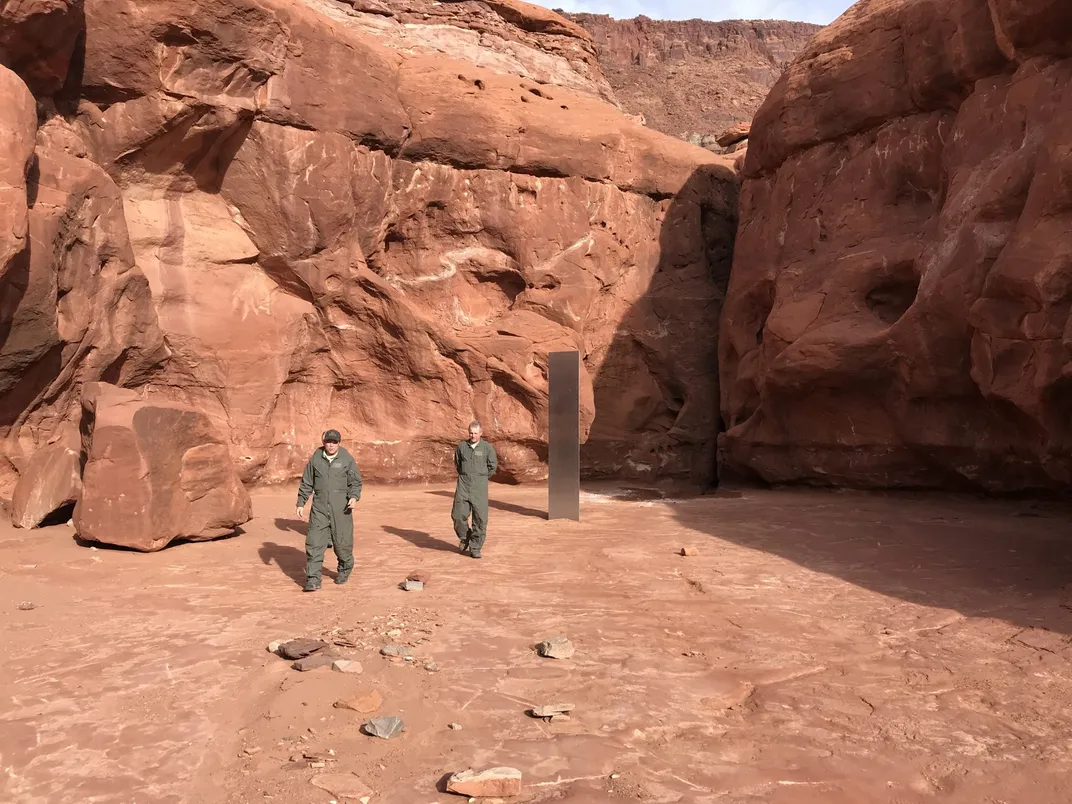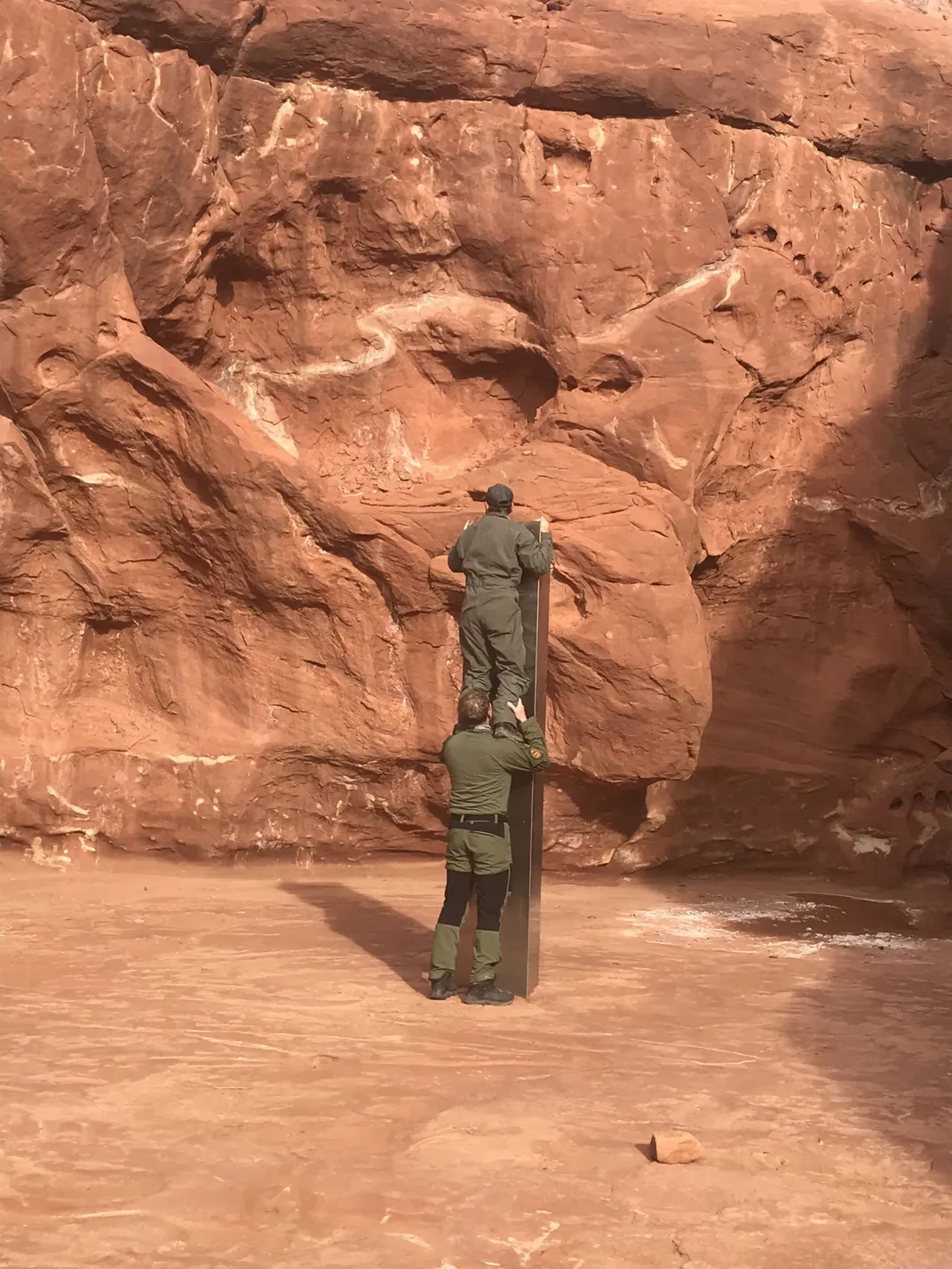A Mysterious Monolith in the Utah Desert Vanished Overnight
Theories regarding the 12-foot-tall metal structure’s origins—and ultimate fate—abound
/https://tf-cmsv2-smithsonianmag-media.s3.amazonaws.com/filer/03/bb/03bbf338-d330-4c29-af1e-79c11ef5f787/utah_monolith.jpg)
Editor's Note, November 30, 2020: Earlier this month, surveyors in Utah's Red Rock Country stumbled onto a 12-foot-tall metal monolith of unknown origin. At some point on Friday night, the structure vanished as suddenly as it had appeared, baffling local authorities and sparking a renewed round of speculation regarding its creation and ultimate fate. Read more about the mysterious monolith below.
A survey crew from Utah’s Department of Public Safety (DPS) flew low in a helicopter over the state’s Red Rocks Country last week, scanning the craggy landscape. The team was working with the Division of Wildlife Resources to count bighorn sheep, which roam in this secluded part of the desert in southeastern Utah.
But instead of the sure-footed climbers, something else caught the researchers’ attention: a shiny metal monolith protruding from the red rocks. The strange, three-sided structure stood out against the surrounding desert and resembled something out of a science fiction movie.
“One of the biologists is the one who spotted it and we just happened to fly directly over the top of it,” pilot Bret Hutchings tells local television station KSL’s Andrew Adams. “He was like, ‘Whoa, whoa, whoa, turn around, turn around!’ And I was like, ‘what?’ And he’s like, ‘There’s this thing back there—we’ve got to go look at it!’”
The crew descended on foot to inspect the object. Up close, the team estimated that the structure stood about 10 or 12 feet high, and was firmly anchored in the rocks beneath, Hutchings tells KSL. “We were kind of joking around that if one of us suddenly disappears, then the rest of us make a run for it,” he adds.
Although the object is clearly man-made, officials still have no clue why it’s there—or who might have put it there, as Leah Asmelash reports for CNN. In videos provided by the Utah DPS, crew members clamber over the sloping red rocks to get a closer look. “OK, the intrepid explorers go down to investigate the alien life form,” one person jokes in the video. “Who does this kind of stuff?”
Utah’s DPS released images and videos of the find on Monday but were careful not to reveal the precise location of the monolith. In a statement, officials warned that curious explorers could get seriously hurt or lost if they attempted to find the structure.
“The exact location of the installation is not being disclosed since it is in a very remote area and if individuals were to attempt to visit the area, there is a significant possibility they may become stranded and require rescue. We are encouraging anyone who knows the location of the monolith to not attempt to visit it due to road conditions,” the department cautioned.
As the monolith sits on federally managed land, the Utah Bureau of Land Management added that “using, occupying, or developing the public lands or their resources without a required authorization is illegal, no matter what planet you are from.”
On the Internet, speculation about the monolith’s origin abounds. As Matt Novak reports for Gizmodo, some amateur Internet sleuths attempted to piece together the coordinates of the structure using satellite images from Google Earth. The structure appears to sit very close to Canyonlands National Park, which leads Novak and others to speculate that it might be a leftover bit of a Hollywood set. A number of well-known movies and television shows have filmed in the park, including HBO’s “Westworld,” which began filming in 2016, Indiana Jones and the Last Crusade, Thelma & Louise, and 127 Hours, to name a few.
The monolith’s structure drew many comparisons to a scene in Stanley Kubrick’s 1968 classic 2001: A Space Odyssey, in which monoliths sent from outer space influence human evolution and transmit mysterious messages from aliens. However, most of that film was shot and produced in England, Novak points out. He continues: “Was the monolith a prop in a big budget movie or TV show? That question is still up in the air, but it seems like a more plausible explanation than aliens. We really wish it was aliens, though.”
For their part, a spokesperson for the Utah Film Commission told the New York Times’ Alan Yuhas that, “To our knowledge, the monolith that was found in Utah this week is not from a film production.”
Some art enthusiasts were also quick to draw comparisons between the strange monolith and the work of John McCracken (1934-2011), an American minimalist sculptor who worked on the West Coast for much of his life, as Gabriella Angeleti reported for Art Newspaper. McCracken’s signature “plank” sculptures typically consist of a single, monochromatic board that leans against a wall, according to David Zwirner, the gallery that represents the artist.
Yet those theories were dashed, at least partly: “While this is not a work by the late American artist John McCracken, we suspect it is a work by a fellow artist paying homage to McCracken,” a Zwirner spokesperson told the Art Newspaper later that day.
Lt. Nick Street, a DPS spokesperson, tells the Times that authorities are confident that the structure is “somebody’s art installation, or an attempt at that.”
The Bureau of Land Management will soon decide whether or not to conduct an investigation into the structure, they announced Tuesday. But while officials remain baffled by the strange object, they’re happy on one count: the sheep-counting mission was a success.
“The sheep are doing well,” Aaron Bott, a spokesman for the Division of Wildlife Resources, tells the Times. “It’s a robust population.”
/https://tf-cmsv2-smithsonianmag-media.s3.amazonaws.com/accounts/headshot/nora.png)



/https://tf-cmsv2-smithsonianmag-media.s3.amazonaws.com/accounts/headshot/nora.png)